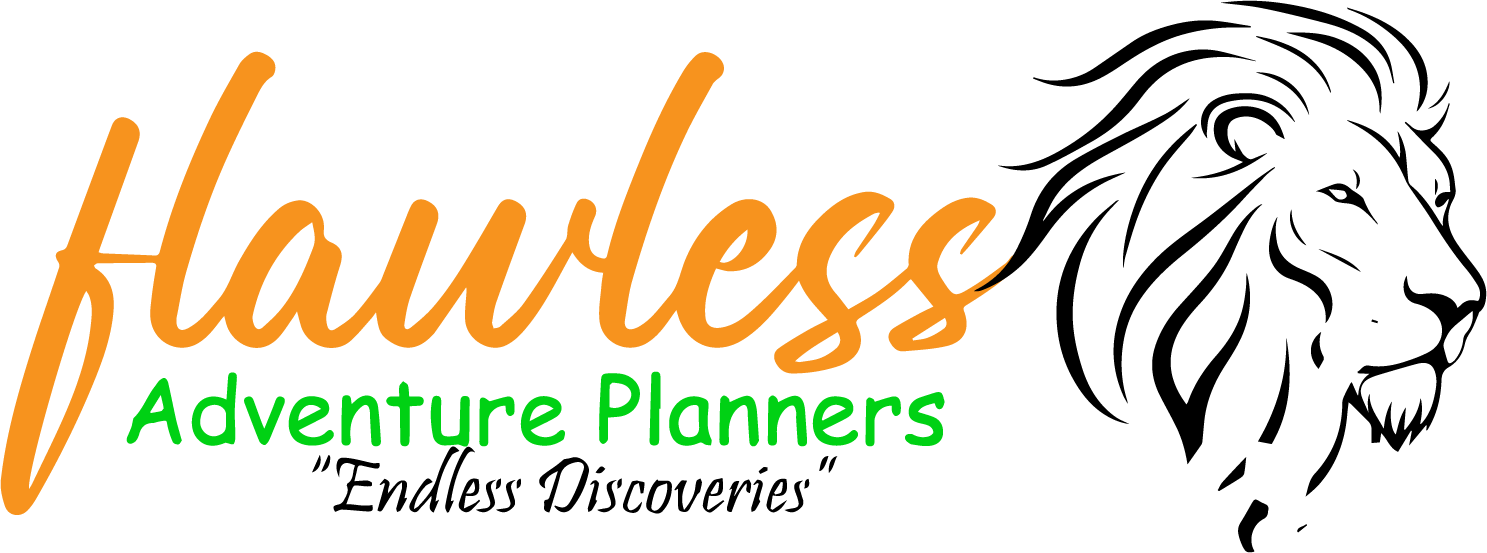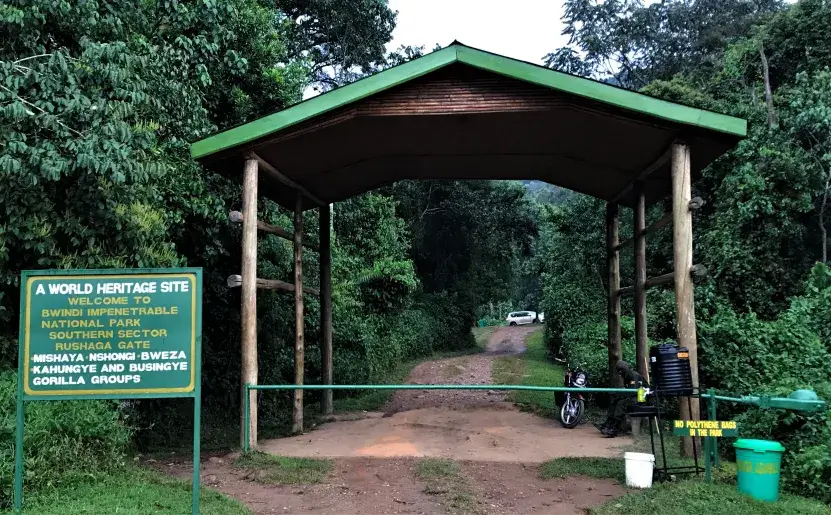Gorilla Trekking in Bwindi Impenetrable Forest
Gorilla Trekking in Bwindi Impenetrable Forest –Updated Guide
Welcome to Our Updated Visitor Guide to Gorilla Trekking in Bwindi Impenetrable Forest National Park, Uganda. To begin with, you notice that few wildlife experiences compare to the thrill of getting up close and personal with the endangered mountain gorillas in their natural habitats. A Gorilla safari in Uganda, particularly in Bwindi Impenetrable National Park, is more than just a primate tour – it is an immersive journey into the raw beauty of Uganda’s most impenetrable jungle, where Mother Nature reigns supreme and every trail holds a story.
Nestled in the quaint southwestern region, Bwindi Impenetrable National Park offers one of the most thrilling gorilla trekking experiences in Africa. The thrill of tracking the majestic Giant Apes in their natural habitat, against the backdrop of an ancient rainforest that is estimated to be over 25,000 years old (one of the oldest in Africa and survived the last Ice age), attracts primate enthusiasts, photographers, and adventure seekers from all over the World.
For a first-time visitor, Bwindi Impenetrable National Park isn’t just a destination for gorilla trekking; it is a deep dive into the jungle soul of Uganda, the Pearl of Africa. Home to almost 50% of the World’s mountain gorilla population, Bwindi is undeniably the top destination to witness these majestic Giant Apes.
However, planning your first- or even second gorilla trekking safari can be overwhelming. With four trekking sectors, travel seasons, and permit requirements, it is easy to feel unsure about where to begin.
That’s why we have put together this step-by-step guide to booking a gorilla safari in Bwindi Impenetrable National Park. It covers everything from choosing any of the trekking sectors/regions, the best time to visit, securing your gorilla permits, choosing the right accommodations/where to stay, and getting the most from your gorilla trekking experiences.
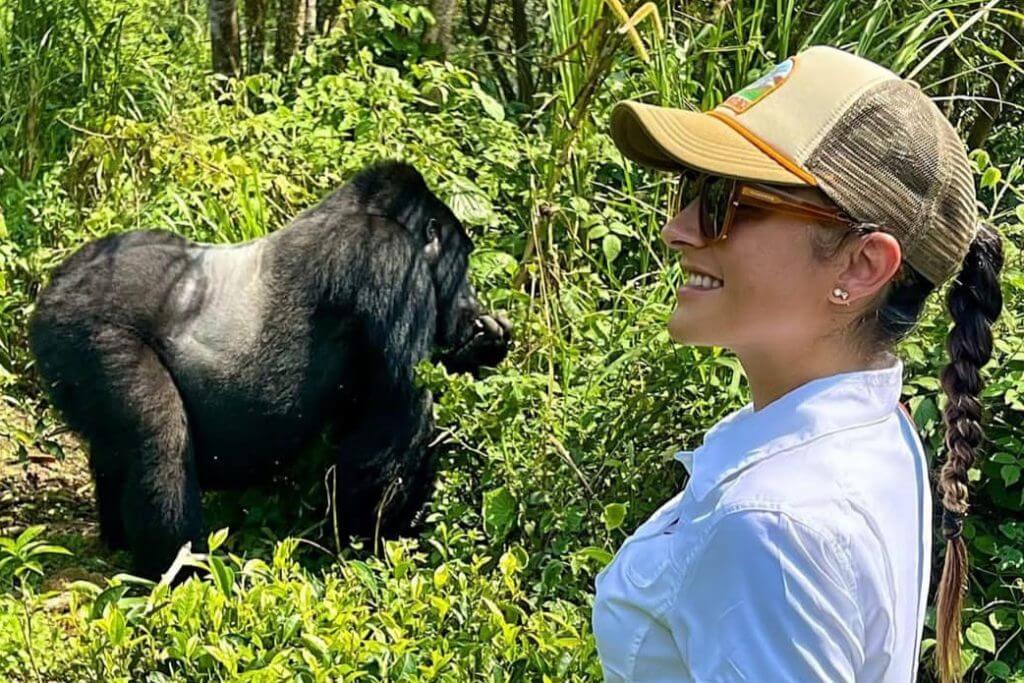
Guide to Gorilla trekking In Bwindi Impenetrable Forest National Park, Uganda
Let us begin- your Gorilla trekking adventure awaits!
Choosing a Bwindi Gorilla Trekking Sector/Region
Bwindi is home to over 480 mountain gorillas living in four sectors/regions- Buhoma in the North, Ruhija in the East, Nkuringo, and Rushaga in the South. Each of these sectors offers an exceptional gorilla trekking experience, and choosing your choice of sector will influence everything- from the accommodation options, to availability of gorilla permits, and how remote/busy the trip feels.
How difficult is Gorilla trekking in Bwindi?
Searching for the endangered mountain gorillas in their natural habitats still stands as one of the most formidable tests of human resilience, as far as wildlife experiences are concerned. The colossal altitude (between 2500 and 4000 meters above sea level) and dense vegetation of gorilla natural habitats, paired with unpredictable terrains and changing weather conditions, make gorilla treks one of the most difficult adventures that travelers can undertake. Even for repeat trekkers, searching for the Giant Apes in their natural habitats can still prove difficult.
However, with moderate physical fitness, appropriate clothing and footwear, and sticking to set trekking rules and regulations, makes primate enthusiasts achieve their dream of getting up close and personal with the endangered mountain gorillas. That said, searching for the Giant Apes in their natural habitat is not for the faint of heart; it takes planning, commitment, perseverance, and a thorough understanding of the challenges you are likely to face.
How Bwindi gorilla trekking is done
A typical day of Gorilla trekking in Bwindi starts with breakfast at the Lodge, followed by a drive/or walk to the Park Headquarters (depending on the location of your accommodation), arriving at 7:00 am.
While at the Park Headquarters, you will have a 30-minute cultural dance from one of the local community groups, then a 30-minute briefing from the Park Rangers to go through the rules and regulations of gorilla trekking.
Depending on the gorilla family you have been allocated (based on physical fitness, age, and preference), you will either walk/or drive to the trailhead. With your Ranger guide and porters (whom you have to hire, though optional), you will slowly start walking through the forest to search for the Giant Apes, and this should last between one and six hours.
After several hours of searching, you will find the allocated gorilla family and remain there for a good hour observing and taking photos of the Giant Apes as they play, eat, rest, nurse their babies, and other routines under the watchful eye of the dominant silverback.
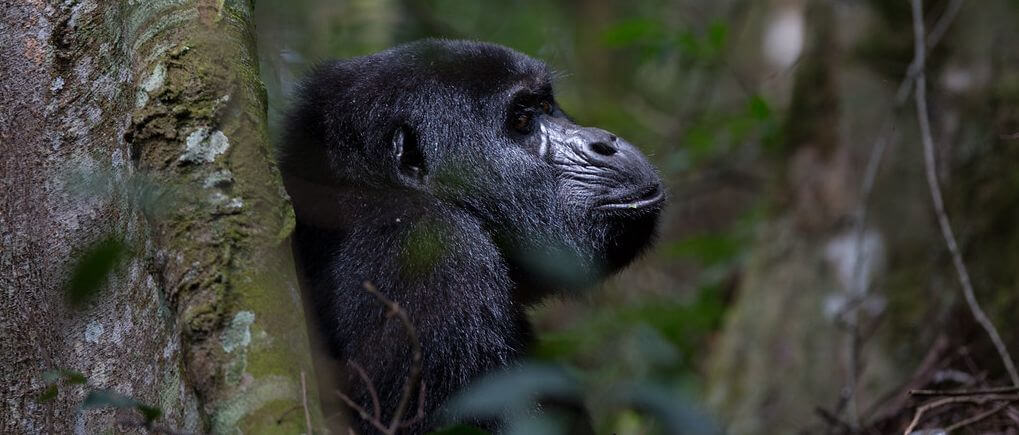
How much is Gorilla trekking in Bwindi?
For you to get the chance to trek Mountain gorillas in Bwindi, you need a gorilla permit whose cost varies based on category. A gorilla permit for foreign non-residents is priced at $800 per person, while for foreign residents it is priced at $700 per person. East African Citizens’ gorilla permits cost Shs. 300,000 per person.
Guidelines for Gorilla Trekking
- Never approach the mountain gorillas: Always maintain a distance of 7 meters from the Giant Apes to avoid disturbing them or making them aggressive.
- Be silent: Don’t make sudden, loud noises when watching the mountain gorillas, as it might alarm them.
- Avoid flash photography: Flash can frighten mountain gorillas as they go about their daily routines, hence spoiling your gorilla trekking experience.
- Always follow what your Ranger guide tells you: It is the things you will learn and keep an eye on when spending time with experienced Ranger guides, as they can read the signs: gorilla calls, territorial markings, and threats. Listen to the Ranger guide and follow their orders closely.
- Follow viewing time: Consider following the recommended viewing time (one hour) to minimize the cumulative impact on them.
- Avoiding feeding mountain gorillas: Feeding the Giant Apes or throwing anything to them is likely to cause disturbance, as they depend on food from their environment and are not fed by humans.
- The maximum number of visitors allowed to track a habituated gorilla family is 8 visitors, and this should be followed at all times.
What to pack for Gorilla Trekking Tour in Bwindi
Gorilla trekking in Bwindi Impenetrable Forest National Park is an experience of a lifetime, and proper preparation as well as planning is necessary to make the safari comfortable, safe, and successful in witnessing the majestic Giant Apes. Here is a hand-picked list of safari essentials to pack;
Clothing: You need loose cotton clothes in green, beige, and brown to fit in and not disturb the Giant Apes. You will need long-sleeve shirts and safari pants for sun protection.
Footwear: You need good and comfortable hiking boots with ankle support for comfortably maneuvering through the jungle while searching for the mountain gorillas in their natural habitat.
Personal care and health: You need an insect repellent to keep mosquitoes (and other bugs) at bay during tracking, sunscreen for sunny weather, a first aid kit (pain relievers, prescription medicines, anti-allergic medicines, and antiseptic wipes), hand sanitizer, and wet wipes.
Photography and viewing gear: You will need a camera with a zoom lens for capturing great gorilla photographs, a pair of binoculars for seeing far-away wildlife and bird species,
Documents: You will need to pack your passport, Visas, gorilla permits, travel insurance, and your travel e-ticket.
A reusable water bottle: This is ideal for staying hydrated and cutting down on plastic waste.
You need energy-giving snacks or bars: These are ideal for keeping energized during the long gorilla trekking adventures.
A backpack: This is handy for storing some of the essentials during gorilla treks, such as your water bottle, snacks, and documents.
Rain jacket: A non-insulated and waterproof rain jacket will serve as a significant outer layer for protection against rain.

Which months are best for Bwindi Gorilla trekking?
The success of your gorilla trekking safari doesn’t just depend on where you go- when you go is equally crucial. Seasons, especially the wet/rainy season, have a major impact on forest trails, and each time of the year brings an outstanding experience to your trekking safari adventure.
The dry season (June to September and December to February) – Peak gorilla trekking season
As rainfall levels reduce, forest trails dry up and make it less challenging to navigate them while searching for the Giant Apes.
This is also the peak gorilla trekking season, with availability of accommodations and gorilla permits being high, hence bookings (6-12 months) are recommended.
The rainy/wet season (March to May, October to November)- low gorilla trekking season
The roads to the National Park are muddy, slippery, and difficult to reach due to heavy rain as well as poor road conditions, and the forest trails are challenging to navigate.
On the higher side, the rains offer verdant green landscapes, hence providing the best backdrops for photography and fewer crowds, hence it is a low season. Therefore, this time of the year is perfect for offbeat visitors seeking solitude, lush greenery, and an exceptional side of the forest.
As a bonus, the wet season is also ideal for bird watching, due to the arrival of migratory bird species.
Where to stay in Bwindi Impenetrable Forest, Uganda
Your gorilla safari experiences in Bwindi Impenetrable National Park go beyond the jungle walks/treks- it is also shaped by where you stay, the quality of hospitality, and how deeply you reconnect with the forest. From luxury Safari Lodges with private butler services to budget retreats run by expert naturalists, accommodations in/around Bwindi Impenetrable National Park vary widely in both comfort and closeness to the Park gates. Where you stay will depend on the sector/region you are visiting.
For your next gorilla trekking safari in Bwindi, you can consider staying at Buhoma Lodge, Sanctuary Gorilla Forest Lodge, Mahogany Springs, Volcanoes Bwindi Lodge, Ride 4 a woman Guesthouse, Gorilla Bluff Lodge, Engagi Lodge, Haven Lodge Buhoma Community, Buhoma Community Rest Camp, and many others in the Buhoma sector.
For Ruhija gorilla trekking, you can stay at Kiho Gorilla Safari Lodge, Bakiga Lodge, Agandi Eco Lodge, Gift of Nature Lodge, Gorilla Mist Lodge, Broadbill Forest Camp, to mention but a few.
For Rushaga and Nkuringo gorilla trekking tours, you can stay at Nkuringo Bwindi Gorilla Lodge, Chameleon Hill Forest Lodge, Four Gorillas Lodge, Clouds Mountain Gorilla Lodge, Ichumbi Gorilla Lodge, Gorilla Leisure Lodge, Gorilla Heights Lodge, Gorilla Safari Lodge, and many others.
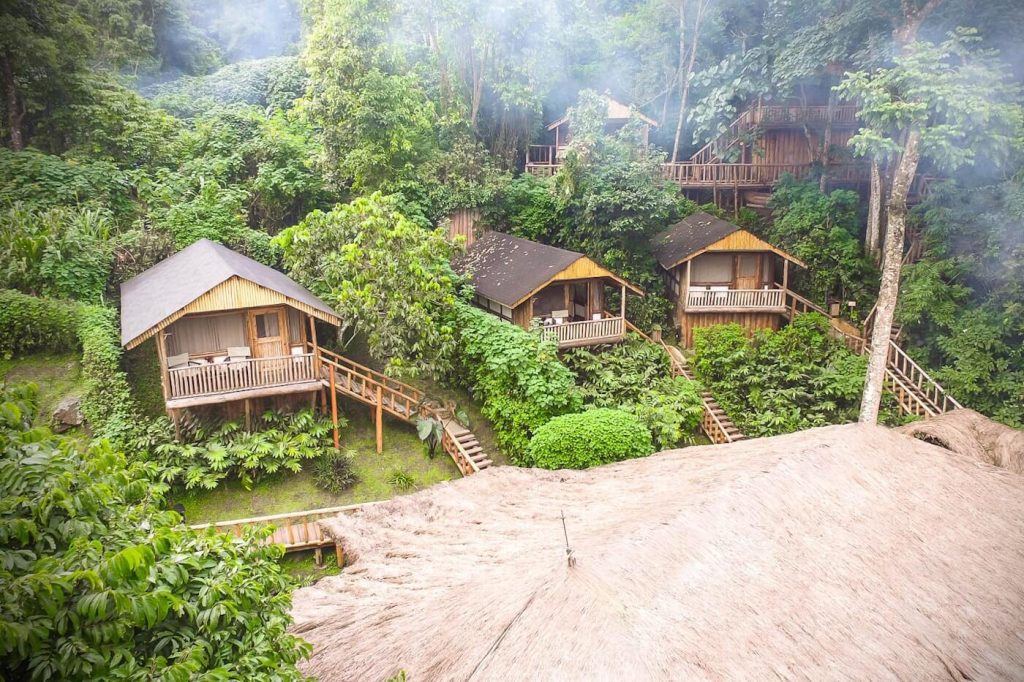
How to get to Bwindi for Gorilla trekking tours
Bwindi Impenetrable National Park is located in the southwestern part of Uganda. The Park is well connected to Kampala or Entebbe by air and road.
However, air is the fastest way to reach Bwindi Impenetrable National Park. The nearest Towns and airstrips of the Protected Area are Kihihi, which is approximately 44 kilometers from Buhoma, and Kisoro, which is 35 kilometers from Rushaga and 45 kilometers from the Nkuringo sector.
Bwindi Impenetrable National Park is also well connected to Kampala, Entebbe, and other major Towns of Uganda, and Kigali (Rwanda) by road.
The Protected Area’s nearby Towns can be reached through different public bus services, private safari vehicles, and taxis. A typical drive from Kampala/Entebbe lasts 8-9 hours, while a drive from Kigali lasts 4-5 hours with border crossing at Cyanika or Katuna.
Now that you have a complete and updated travel, planning your next gorilla trekking safari tour to Bwindi is made easier. Talk to our experts to start the process in advance and don’t wait till the slots are over!
